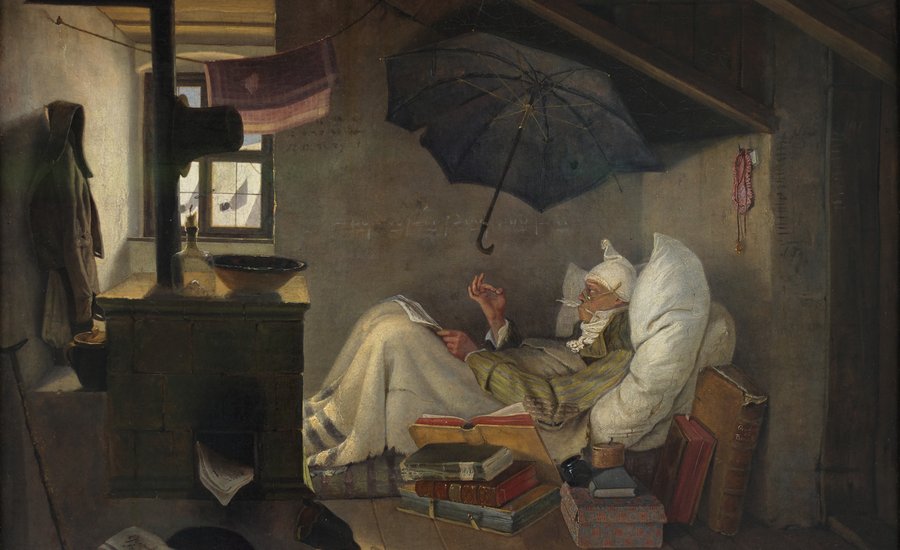
THE TAKE
New Study Shows Artists "Like" Being Poor—But the Starving Artist Stereotype Has Got to Go

In recent study published in the "Creativity Research Journal," a team led by Dr. Roberto Goya-Maldonado over in Göttingen, Germany hoped to crack a mystery that’s long plagued cultural producers. Since our cave dwelling ancestors adorned the walls of Chauvet and Lascaux, painters, writers, sculptors, et al. have wondered: Why don’t artists make any money (or, in our cavewoman’s case, a hard-earned haunch of primordial elk)? According to Dr. Maldonado’s findings, the answer is quite simple. It turns out, creatives just don’t like the stuff! Who knew?
This remarkable conclusion was reached after monitoring and comparing fMRI scans of 24 participants, half of whom were artists and the other, self-identified “non-creatives” including a dentist, an engineer, and an insurance salesman. Participants would each don a set of goggles which showed a series of squares in different colors. Upon seeing a green square, they could select it with a button and receive 30 euros. They were also asked to select other colors, but those did not include any financial reward.
What the fMRI scans revealed was that when artists selected the little green money squares, the part of their brains responsible for reward systems (the ventral striatum) was significantly less activated than those of their non-creative counterparts. The study also found that the artists did get a dopamine rush when they were asked to reject the green squares. As an Artnet article on the study put it, “artists get less worked up about receiving money and more worked up when they know they can’t have it.”
While it’s easy to fall into the poetic romanticism of this study, it is also patently irritating to try to rationalize the trope of the starving artist with a not-very-thorough scientific study (12 artists is not a large sample by any standards). Essentially, what Dr. Maldonado’s research implies is that artists are physiologically prone to reject money, thereby putting the fault of poverty on artists themselves. What it ignores are all of the socio-cultural factors that have led to the starving artist stereotype—like, maybe artists are underpaid because society has refused to compensate the vast majority of them fairly. Maybe they’re caught in a feedback loop where the cultural expectation of the starving artist has conditioned many creatives to devalue money.
Earlier this year, a survey conducted by the Creative Independent gathered information from over 1,000 artists on the state of their finances. Among their findings, it discovered that the average median income for artists was between $20-30k per year with nearly 60% of respondents reportedly making less than $30k annually. To put it in perspective, that’s about $10k less than the national average. Additionally, the survey also found that both women and minority artists made an additional $10k less, typically falling within the $10-20k bracket. But is this because artists just don’t want to be making more? That they’re actually mentally incapable of wanting money? Does that mean women and minorities are even more physiologically apathetic when it comes to finances?
To say artists are starving because of some cognitive hard-wiring is kind of like saying there are no great women artists simply because women just aren’t very good at art. Not only is the argument a reductive catch-22, but it perpetuates systems that continue to neglect the underserved (particularly women and minority artists of color). A telling 2003 survey conducted by the Urban Institute found that while 96% of Americans value art in their communities, only 27% of them value actual artists.
“We have bought into the myth of the Starving Artist, thinking of artists as unfortunate Bohemians who struggle at the lowest end of society” writes Jeff Goins, best-selling author of the book “Real Artists Don’t Starve.” “This myth is hurting creative work everywhere.” Maybe it’s time for “non-creatives” to stop perpetuating the stereotype of the starving artist. Maybe we ought to start valuing our cultural producers on the same terms with which we value their work. Maybe the Van Goghs and Nina Hamnetts throughout history needn't have starved had we looked on at artists with a little less scorn and had been a little less lazy about our expectations of what artists are truly worth.
Related Articles:
No comments:
Post a Comment